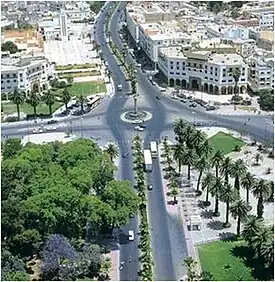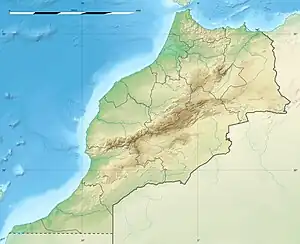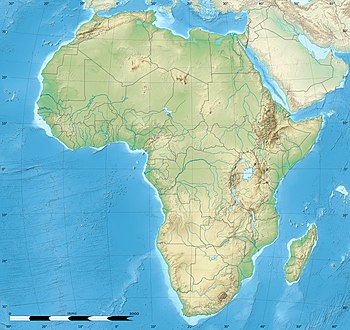Settat
| |
|---|---|
Municipality and city | |
    FST Settat | |
 Flag | |
 Settat Location in Morocco  Settat Settat (Africa) | |
| Coordinates: 33°0′N 7°37′W / 33.000°N 7.617°W | |
| Country | |
| Region | Casablanca-Settat |
| Province | Settat |
| Elevation | 370 m (1,210 ft) |
| Population (2014)[1] | |
| • Total | 142,250 |
| • Rank | 22nd in Morocco |
| Time zone | UTC+1 (CET) |
Settat (Arabic: سطات, romanized: siṭṭāt, Berber languages: ⵥⴻⵟⵟⴰⵜ, romanized: ẓeṭṭat) is a city in Morocco between the national capital Rabat and Marrakesh. Settat is located 83.9 km (52.1 mi) by road south of the centre of Casablanca, roughly an hour's drive.[2] It is the capital of Settat Province and is its largest city in both size and population. According to the 2014 Moroccan census, it had a population of 142,250 people,[1] up from 116,570 people in the 2004 census.[3] Settat is 370 m (1,210 ft) above sea level, built on a plateau surrounded by foothills in all directions. The antiquities of Settat include the very old Ismailiya Kasbah distinguished by the statue of a steed which lies at the center of the city.
Etymology
The name Settat comes from "Ayt Settat" a Senhaja-Berber clan of the Houara tribe.[4] They belonged to the Masmuda-led Almohad alliance according to al-Baydaq, Ibn Hazm and Ibn Khaldun.[4] Their origin is south-east of the High-Atlas and they seemingly settled in the Chaouia region as a result of the Almohad advance to the north.[4]
History
By choosing to build the Kasbah on the hilly site of Settat, 18th century Moroccan ruler Moulay Ismail would trigger the process of urbanization. Indeed, the building of the Kasbah brought order and security for travelers and residents supported the settlements near it. Moreover, by installing the first Caïd in the region which previously depended Caïd Doukkali and Rahmani, Moulay Ismail formalized Settat status as capital of this region.
Settat became an administrative center in the early 18th century, due to its strategic position as an unavoidable passage between North and South. Thanks to the richness of the soil, it also prospered during the 18th and 19th centuries as an important trading center for agricultural products, attracting entrepreneurs. This was the case for Moroccan Jews who settled here en masse in the 19th century, building their own neighborhood, the Mellah, near the Kasbah.
This development was disrupted in the early 20th century during the early chaos of the French colonization when the Chaouia tribes rallied to Moulay Hafid. However, under the French protectorate, the city of Settat had unprecedented urban development, as evidenced by the population boom it experienced from 1913 to 1925. This prosperity lasted until the early fifties when, as a result of the development of Casablanca, communications, and transportation, the city of Settat and other towns in the region have entered a period of semi-lethargy.
In the early 1990s, Settat was endowed with a university L'Université Hassan 1er de Settat,[5] an international golf course,[6] and a racetrack. Settat has undergone large-scale urban planning from the 1970s to become an important regional center. Settat is linked to Casablanca (57 km [35 mi] to the north) since 2001 by the A7 highway, and Marrakech (146 km [91 mi] to the south) since 2007.
Cities and Towns of Settat's region
Notable people
- David Amar (1920-2000), Moroccan Jewish businessman[7]
- Jo Amar (1930-2009), Moroccan-Jewish singer[7]
- Driss Basri (1938-2007), Minister of the Interior under Hassan II
- Bouchaib Benlabsir (1931-1991), deputy mayor of settat city
- Abdellah Bendhaiba (1950-), Former Wali of Doukkala-Abda, Governor (Khouribga, Nador, Taroudant) and Parliamentarian (Settat)
- Habib Mazini, novelist
- Mohamed Moâtassim (1956-), adviser to King Mohammed VI
- Ahmed Nejmeddine (1962-), President of the Hassan 1st University of Settat.
- Abdel Abqar, footballer
- Yahya Jabrane, footballer
Sister cities
Gallery
References
- 1 2 "POPULATION LÉGALE DES RÉGIONS, PROVINCES, PRÉFECTURES, MUNICIPALITÉS, ARRONDISSEMENTS ET COMMUNES DU ROYAUME D'APRÈS LES RÉSULTATS DU RGPH 2014" (in Arabic and French). High Commission for Planning, Morocco. 8 April 2015. Retrieved 29 September 2017.
- ↑ Maps (Map). Google Maps.
- ↑ "Recensement général de la population et de l'habitat de 2004" (PDF). Haut-commissariat au Plan, Lavieeco.com. Retrieved 22 April 2012.
- 1 2 3 Kitab al-Ansab fi Marifat al-Ashab (The book of Genealogy for the knowledge of the companions), al-Baydaq, reviewed by Abdelwahab Benmansour, pp53, 1971
- ↑ "L'Université Hassan 1er de Settat". L’Université Hassan 1er de Settat. Retrieved 22 April 2012.
- ↑ "Settat University Royal Golf Club". Worldgolf.com. Retrieved 22 April 2012.
- 1 2 "Encyclopedia of Jews in the Islamic World — Brill".


